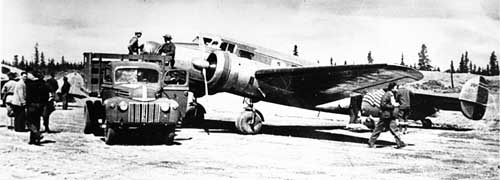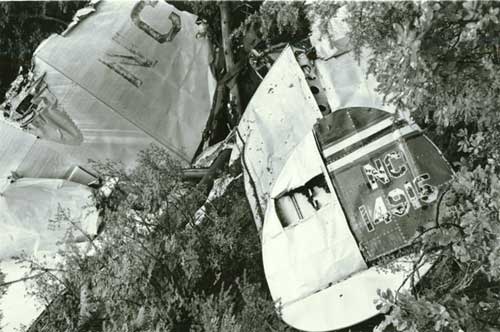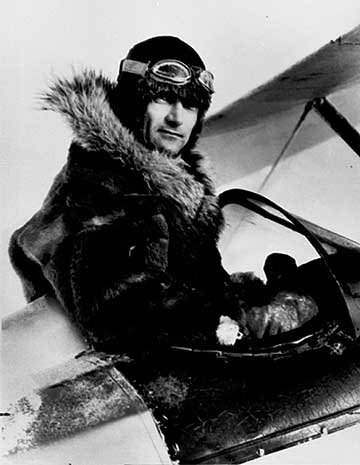 Harold Gillam: A Tragic Final Flight Ketchikan remembers the search By June Allen August 17, 2004
There were, of course, times the weather was indeed as bad as it looked and Gillam had his share of heart-stopping takeoffs, hairy landings, and more than a few minor accidents and serious crashes as well. But it was said that he had cat's eyes and could fly in the winter darkness as well as the daylight. Early in his career the lucky pilot had been given the nickname "Thrill 'em, spill 'em, no kill 'em Gillam." That nickname held until Jan. 5, 1943 and his final crash landing on a mountaintop within today's 2.3-million-acre Misty Fjords National Monument. The crash site is almost due east from Annette Island, about 15 miles across choppy Revillagigedo Channel. Not only was it the most remote location possible for a crash, it was during one of the most severe winters in the history of Southeastern Alaska. There were unusually frigid temperatures and sixteen feet of snow on the ground. The saddest part of the tragic crash is that the immediate rescue efforts failed to find a trace of the plane. The accident site, as remote as it is, was just east of the Annette Island's wartime airfield where Gillam planned to refuel - and just sixteen air minutes south of Ketchikan, at the time one of Alaska's largest cities! Gillam had radioed Annette with the urgent messages, "I am in trouble!" and "One engine is out." Then silence. It was assumed that pilot Gillam and his five passengers had perished by plunging into the choppy winter waters of the entrance to Alaska's fabled Inside Passage. A search for the downed aircraft and survivors was initiated even though it was believed the plane was at the bottom of the ocean. The search was called off after a little more than two weeks. It was assumed that fate had finally caught up with the adventurous Harold Gillam, the lucky pilot who had never had a fatality. He would be mourned. Harold Gillam was born in 1903 in Kankakee, Illinois and grew up in Chadron, Nebraska. He ran away from home at the age of sixteen and joined the Navy, serving several years on a destroyer in the Pacific. Mustered out in 1923, he end up in Seattle where he worked what jobs he could find. In an American Legion Hall he saw a posted advertisement for men to work in construction in Alaska. The 20-year-old set out for the north country. Gillam was not a big man, but he was burly, with great upper body strength. Like many men of his generation, he was a born-hard-worker. With his thick black hair and dark eyes under bushy black eyebrows plus a silent, brooding personality - he was said to be quite attractive to the young ladies. In those days someone with those Irish attributes was called "a black Irishman." He was never really "pals" with his contemporaries, preferring his own company and his own rules. At first he worked several years for the Alaska Road Commission and then struck out on his own in Fairbanks as a freighting and road work contractor. It was when he was grading the long stretch of Fairbanks' Weeks airfield just south of city center that he became interested in and finally enamored of airplanes. He had met his future as a bush pilot head on. It was there that he also met the lovely young Marvel Crosson, bush pilot Joe Crosson's sister, who, like her brother, was an aviator. Gillam and Marvel became engaged. Gillam then had one more reason to continue with his flying lessons. He was said to be a "natural," with an innate sense of direction as well as sharp eyesight. 
Every available plane and pilot in Alaska took off for the tiny Eskimo village of Teller, the search base location 70 miles north of Nome on the Seward Peninsula. There the pilots gathered around a hot stove to share information and suggestions before taking off over the all-white expanse of the Bering Sea and then the equally white expanse of Siberia. Although young Harold Gillam did not yet have his pilot's license, his mentor, famous bush pilot Joe Crosson, had allowed him to join in the Eielson search in a borrowed airplane. And during the search, it was rookie Gillam's incredibly sharp eye that sighted a tiny sliver of a darker shadow on the blank white snow. The shadow turned out to be the slanted wing of a buried airplane. It was Gillam who had spotted the crash site! After days of digging, the bodies or Borland and of famous Carl Ben Eielson were recovered on Feb. 18, 1930. Harold Gillam's name joined Eielson's in headlines of the daring search effort. Gillam was making a habit of making headlines! While he was still a student pilot, he had the distinction of being a survivor in Alaska's first aviation fatality. He was riding in a two-place Swallow biplane with instructor M.L. Danforth when the plane veered out of control and spun to earth. Danforth died two days later, but Gillam, with cuts and gashes on his head and hands, refused even to be hospitalized. Still with stitches in his wounds, he was flyng again. But when Gillam returned to Fairbanks from the Siberian rescue flight, he had to deal with the devastating news of the death of his fiancé, Marvel Crosson. In August of 1929, while flying a Travel Air, she had crashed during a Women's Air Derby near Welton, Arizona. With her plane in a tailspin, she had attempted to bail out, but her body and unopened parachute were found close by the wreckage. As years passed, the slow-to-smile and uncommunicative Gillam was learning how to deal with his press notices, in fact, his headlines. He said little or nothing. The daring and sometimes reckless young pilot's adventures would be featured in many word-of-mouth and printed stories over the next 14 years. All of America was in love with airplanes and the daring pilots who flew them! Even the syndicated comic strips of the 1930's had their share of national aviation adventurers such as Tailspin Tommy, Skyroads, Barney Baxter and of course the famous Smilin' Jack. Who can forget Smilin' Jack's delightful sidekick Pancho (?), whose buttons popped off the shirt over his too-round tummy and into the craw of a tag-along rooster. Pilots were the heroes of the nation! Those were also the days of daredevils within the aviation industry. By 1931 Gillam had left his home base in Fairbanks and relocated to Cordova, where the U.S. Army had built an airfield for stopovers of its own planes. Gillam was hired to fly the railroad route to the booming Kennecott copper mines and even over this relatively easy route he suffered six minor crashes in as many months. Over the following decade he, like other Alaska bush pilots of the era, flew wherever opportunity and pay took him across the north country. Then in the first week of January 1943, Gillam was flying for Morrison-Knudsen contractors (M-K) one of the prime builders in Alaska during the hurry-up construction years of World War II. He was in Seattle on a routine run to deliver freight and passengers to Anchorage. He warmed up his twin-engine Lockheed Electra - a plane almost identical to the one flown by Amelia Earhart in her final, ill-fated voyage across the Pacific. Gillam discovered an oil leak in one of his engines and, as he had many times before, patched it up with tape and shellac. It would prove this time to be a disastrous mistake. Because of the repair he was late taking off. Aboard the plane were five passengers: Robert Gebo, M-K's Alaska general contractor; Percy Cutting, the company's mechanic; Joseph Tippets, CAA engineer (now renamed the FAA, Federal Aviation Administration); Dewey Metzdorf, Anchorage railroad and hotel man; and young Susan Baxter, a stenographer headed to Anchorage to work for the FAA. The weather reports for the route northward were rather routine for a Southeastern leg of the flight - dense fog, cold and gray. Gillam flew on instruments along the way and maintained total radio silence. It was wartime, just a little over a year since the Pearl Harbor attack, and enemy submarines had been sighted along the coast of Alaska and reports received of incendiary bombs lobbed toward coastal installations.  Photographer: Don Dawson Donor: Ketchikan Daily News, Photo courtesy Ketchikan Museums
Because of enemy aircraft pressure in the area, the Annette Island airfield occasionally changed its "instrument beam" signal to confuse any enemy aircraft in the area. It also confused Gillam, who, on his earlier flight southbound, had trusted a different signal. According to an account related by passenger Joseph Tippets, "We hit a violent downdraft and dropped 4,000 feet almost before we knew it. It was pitch dark and the fog was almost down to the ground, but now and then through a hole we could peaks or trees flashing by. We were still flying at full speed. I yelled at Metzdorf to fasten his seat belt! The plane swerved just in time to miss one mountain. Then we saw another one looming up straight ahead. There was an open spot toward the top and Harold gunned the engine trying to make it. But our right wing hit a tree. I could feel everything leaving my body, everything blacked out, then it all came back. I was lying in the dark in the drizzling rain. I called out to the others. There was no answer. All I could hear was the hissing of the hot engine in the snow." In the minutes that followed the others awoke and began to assess injuries. The cockpit had been crushed on Gillam but he seemed to suffer only from a gash to his head. Susan Baxter's injuries were the worst. She suffered a head injury and her right arm was caught under the debris, broken and bleeding. Sadly, after freeing her from the airplane, the young woman died two days later. Gebo and Metzdorf were seriously injured, with multiple broken bones. Tippets and Cutting were both battered and had broken bones but in the best condition of the survivors. Gillam set to work immediately, fashioning snow shovels from the aluminum body of the airplane, he built snow shelters, lighted fires and fixed the stores of food. They could hear the blasting of construction work on Annette Island. Planes flew overhead, but the trees hid any sight of the survivors. Rescue didn't arrive. On the sixth day Gillam set out alone. He told the others, "I'm going up on a ridge. Maybe I can sight a definite landmark. If I do I'll got to it." He didn't return. Cutting and Tippets set off down the mountainside in spite of their injuries. They dragged Gebo and Metzdorf to a spot lower down the mountainside and made them as comfortable as possible. Then they set out - if rescue didn't come to them, they would head for rescue. The story of the hardships all of them endured is almost unbelievable! It was a month after the crash that the survivors were finally found! By chance, a Coast Guard patrol vessel spotted Cutting and Tippets' fire on the shoreline of Boca de Quadra. As the boat drew near, they thought they were seeing two bearded, isolation-deranged trappers stumbling crazily along the beach! The survivors cried out, "We're from the M-K plane that crashed a month ago!" Help at last! The electrifying news was flashed across the miles and Ketchikan Volunteer Rescue Squad members responded. Tippets and Cutting were rushed to the hospital. Then Gebo and Metzdorf were found alive but in critical condition and rushed to aid. Searchers found Gillam's frozen body wrapped in a parachute on the shore of Boca de Quadra, only a mile from where Tippets and Cutting were finally rescued. Gillam had torn his red underwear and tied the pieces to the spruce branches nearby. Over two tall poles stuck in the snow he had put his flight boots. Cutting later reported that he explored the surrounding area and found signs that Gillam had broken through a stream. He believed that the aviator had hung up his clothes to dry and lay down for a rest and never awakened. No autopsy was made and the cause of his death remains unknown. The young woman's body was sent home for burial. Gillam is buried in Fairbanks' Pioneer Clay Street Cemetery, under a stone that reads, "Greater Love Hath No Man."
Information about Ketchikan's
role in the final rescue can be found in Ken Eichner's new book,
Nine Lives of an Alaska Bush Pilot, which can be purchased at
Parnassus Book Store in Ketchikan or online at www.amazon.com
.
june@sitnews.org
All rights reserved. Not to be reprinted in any form without the written permission of June Allen.
|






